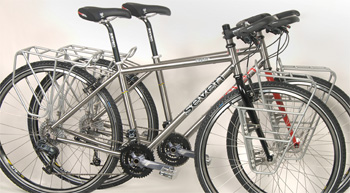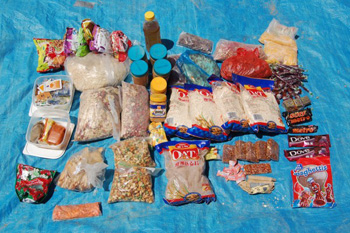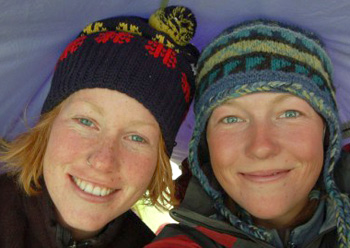
In the first of our series of articles on the 2011 Cycling Silk Expedition, we wanted to ask Kate Harris and Mel Yule about their preparations for a 12-month transcontinental journey by bike. Most of us can identify with the difficulties of packing for a typical weeklong vacation. Even if we forget something, in most cases we can purchase the item at our destination or make do until we return home. That’s not an option for these explorers. The stakes get raised when you are spending long stretches of time in sparsely populated areas without easy access to supplies. We thought it would be fascinating to learn how they approach the problem. We were surprised to learn how their responses reveal so much of their personalities; they tackle the each situation with a special combination of planning, improvisation, humor and fortitude that will prepare them to face whatever unfolds during the expedition.
1. Where do you start? Do you begin by figuring out the maximum amount you can carry, or do you begin with a list of items that you pare down? Take us through your thought process.
We start with basic necessities: the gear we need to sleep, eat, ride, take photos and shoot video. Once we have these items packed, there’s little room for anything else beyond iPods, a chocolate bar for emergency mental breakdowns, and the harmonica we still haven’t learned how to play but vow we’ll master yet.
2. What is the total estimated weight of your panniers?
80-100lbs including water and food.

3. How many times do you pack and repack prior to leaving?
We usually, if unwisely, leave packing to the very last minute, namely the day before we fly. At the very least, this panicked approach to packing offers perspective: actually biking the Silk Road seems easy after the stress of preparing to bike the Silk Road!
4. What packing lessons did you learn on your previous expedition in 2006? Are you bringing more or less this time?
On our last trip, we were hauling everything but the moon on our bikes, or at least that’s how it felt. However much the laws of physics might disagree, we can attest that ounces multiply to pounds when you’re climbing 17,000 foot passes in the mountains, or spinning wheels through desert sands. But to the chagrin of our quaking legs, we’re actually bringing more gear this time. Since the goal of Cycling Silk is to encourage people to think beyond borders, especially where wilderness conservation is concerned, we’re hauling along more cameras and electronics to document and share the adventure. Since this is a year-long adventure, involving four seasons of elemental exposure, we’re also using heavy duty – and heavy – camping equipment and clothing. So in some ways we’re traveling light on this trip, in others we’re as burdened as bikes will permit.
5. What items are absolutely required?
Beyond bikes, sleeping bags, a tent, and a stove, this kind of trip absolutely requires a few things: a capacity for endless astonishment, an appetite for monotonous meals, an appreciation for all kinds of weather, from storms to sunshine, and above all, a spirit of adventure. The rest is baggage and details.
6. Do you have any items that aren’t necessities, but you choose to bring anyway?
See 1.
7. Do you divide some of your equipment between the two of you? Things like shelter, cooking equipment, etc? Who gets responsibility for which items?
We try to divide the gear by weight as evenly as possible.
8. What gear do you bring that facilitates your research?
We carry a laptop to store research and information on the transboundary conservation initiatives we’re exploring, and to process the interviews, videos, and photos we take along the way, updating our website as frequently as Internet access permits.
9. Are there any items that you try to locate once you’ve arrived in country?
Peanut butter adds protein and tasty flair to both oatmeal and instant noodles, so we stock up on it whenever and wherever we can find it. Instant coffee revs us up to ride each morning. Between these two dietary staples, we can make a gourmet feast of any meal – at least it tastes gourmet when you’re really, really, really hungry.
10. Any special tricks or tips that other adventurers have taught you?
Try to make every item of gear count for at least two purposes. For example, a toothbrush can be used to clean teeth and bike chains; maps can be used to navigate and fuel campfires (but importantly, and hopefully, not at the same time.)
11. What everyday items do you find you don’t need when you are riding the Silk Road?
Fashion sense, good hygiene, and a varied diet are aspects of everyday life mostly irrelevant while riding the Silk Road.
12. What types of emergency supplies do you bring?
Both of us took an 80-hour Wilderness First Responder course in preparation for this trip, because scary as it is, we are each other’s most reliable medical care for long stretches of the Silk Road. We also have a SPOT tracker that lets us send “All is well” or “HELP!!!” messages to parents and authorities.
13. You will face a variety of climate and terrain challenges during the expedition. How do you test some of your equipment beforehand?
In terms of confronting winter on the Silk Road, Kate spends as much time as possible exploring wild, cold, remote places and living in a tent, so she’s field tested a bunch of expedition clothing and equipment. Mel, by contrast, spends as much time as possible avoiding the cold, so she’s trusting Kate to choose the equipment that will minimize shivering during winter on the Silk Road. And with the clothing we’ve packed, we’re ready to face everything from polar freeze to desert heat.
14. What navigational tools will you rely on?
When we come to a fork in the road, we rely on faulty maps, vague or incorrect verbal directions, a GPS unit, gut instinct, pure whim, and rocks/paper/scissors games to decide which direction to go next.
15. Is there anything you bring to remind you of home?
On each trip we bring a small album with photos of family, friends, pets, and homes. Not only do the photos assuage our homesickness, but when language fails as a point of connection with people we meet along the way, photos open up a different kind of dialogue. On past trips, everyone we met was totally fascinated by these glimpses into life on the other side of the world, these representations of what a horse, dog, mother, or brother look like in Canada.
16. Do you bring any gifts or items to trade with the people you meet? Have you ever received something treasured in return?
Since we can’t carry much else beyond our own gear, leaving little room for gifts, we are bringing postcards to give to people we befriend along the way, featuring the route map, photos, and “Cycling Silk: Biking for wilderness conservation across borders” written in Turkish, Russian, Chinese, Hindi, and English. As for gifts we’ve received, what we’ve treasured most on previous trips is being welcomed into family homes, from mud huts to yurts, with a generosity of spirit almost unheard of in North America.
17. They say the more you know, the less you need. What skill do you wish you had that you’d trade in place of some gear?
We wish we each had an internal compass to navigate by, rather than a GPS unit and dubious maps. Telepathy would be a handy substitute for a SPOT tracker, a skill that would allow us to notify people that we’re safe and healthy without relying on yet another electronic device.
18. Best makeshift gear item:
On our last trip through China, we stashed some hundred-dollar bills in our handlebars, thinking the bikes themselves would make perfect piggy banks. This worked really well until we needed the cash…and couldn’t get it out. After four months on the road, the bills were as good as glued to the inside of the bars. So our best makeshift gear item was made from two chopsticks connected with duct tape, an improvised tool – patent pending – for poking and prodding the money out.
19. If you could invite a third person on the expedition, who are they and what would you ask them to bring?
Our ideal third teammate would be a professional bike mechanic and masseuse, fluent in all Silk Road languages, with the voice of David Attenborough so they could narrate the documentary film as we go. If you meet these qualifications, do get in touch.

20. Recount your most amusing gear failure.
On the first day of our 2006 bike trip through China, we snapped a tent pole, Mel’s down sleeping bag rolled off a cliff into a river, we broke our stove pump, and we were forced to burn some of our maps to fuel a fire to cook our instant noodles. But we were so happy to be out there, riding the open road, sleeping under the stars, that none of it really mattered. On trips like this, you learn to take failures as a matter of course, and to do the best you can with whatever resources you have.
